8 Drone-Related Security Dangers8 Drone-Related Security Dangers
How can drones cause havoc? Let me count the ways.
March 9, 2017

“With drones, whatever security you thought you had is gone,” declares Kunal Jain from the drone security company Dedrone (San Francisco). While most people don’t yet equate drones with security risks, they pose an array of threats, and reports of drone-related accidents and near-misses are on the rise. With some one million drones entering the airspace globally each month, the prospect of securing drones is becoming more daunting. “Think of nearly any worst case scenario, and you can probably do it with a drone,” Jain says.
Related: Join us on Thursday, March 23 at 12 p.m. PST. for a Twitter chat dedicated to drones at #IoTBizChat.
Here are eight drone-related risks:
1. Airspace Threats
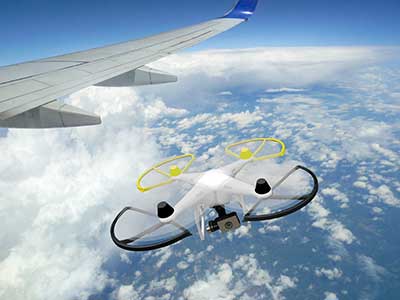 Imagine the level of damage a swarm of drones could cause if they were sucked into a jet engine. While most airports ban drones from flying near them, such rules may potentially be hard to enforce. “The scary thing is that all of the airport approaches for aircraft are published with great accuracy,” says Joerg Lamprecht, cofounder and CEO of Dedrone. Because planes’ autopilot modes fly according to a precisely predefined flight, it wouldn’t be overly difficult for a drone operator to position a drone right in the middle of this flight path—whether near an airport or anywhere else along an airplane’s flight path. “Now, you don’t have to even be in the airport to cause a problem,” Jain adds.
Imagine the level of damage a swarm of drones could cause if they were sucked into a jet engine. While most airports ban drones from flying near them, such rules may potentially be hard to enforce. “The scary thing is that all of the airport approaches for aircraft are published with great accuracy,” says Joerg Lamprecht, cofounder and CEO of Dedrone. Because planes’ autopilot modes fly according to a precisely predefined flight, it wouldn’t be overly difficult for a drone operator to position a drone right in the middle of this flight path—whether near an airport or anywhere else along an airplane’s flight path. “Now, you don’t have to even be in the airport to cause a problem,” Jain adds.
2. Vehicles for Weapons
Think of any light- to medium-weight weapon, and it can probably be attached to a drone. There are already videos of drones with chainsaws, machine guns, and flamethrowers attached.
But a prankster or terrorist could cause havoc with even the simplest of weapons. Imagine the reaction if a drone hovered above a popular sporting event, sprinkling an unknown white powder over the crowd. “A stunt like this would cause pandemonium, even if the powder in question was merely powdered sugar. You would have to have everybody quarantined because you don’t know what that substance was,” says JB McDowell, a sales engineer at Dedrone. “And stadium owners around the nation would freak out and postpone games and increase security.”
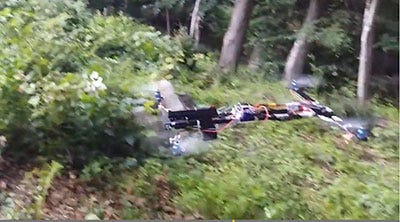 Terrorists are beginning to employ drones for both reconnaissance and combat operations. And such unmanned aerial vehicles could be used to deploy dangerous chemical weaponry, drop bombs, or even carry out nuclear attacks. Former U.S. President Obama described a possible scenario in which terrorists spread radioactive material over a densely-populated area. South Korean President Park Geun-hye agreed in a meeting last April that the risk was real: “We must actively respond to the threat of drones being used to spread radioactive materials or infiltrate nuclear facilities.”
Terrorists are beginning to employ drones for both reconnaissance and combat operations. And such unmanned aerial vehicles could be used to deploy dangerous chemical weaponry, drop bombs, or even carry out nuclear attacks. Former U.S. President Obama described a possible scenario in which terrorists spread radioactive material over a densely-populated area. South Korean President Park Geun-hye agreed in a meeting last April that the risk was real: “We must actively respond to the threat of drones being used to spread radioactive materials or infiltrate nuclear facilities.”
But terrorists wouldn’t need access to nuclear materials to cause havoc. They could, for instance, decide to poison the water system by flying a drone over a water facility and drop poison inside.
3. Low-Tech Corporate Espionage
In a famous scene in the HBO series Silicon Valley, a circle of men—purportedly venture capitalists—sit around a boardroom table. Three members of the startup Pied Piper take turns explaining how their technology works, jotting algorithms and formulas on a whiteboard while the men sitting around the table furiously jot down notes and later snap smartphone pictures. The engineers are impressed with how engaged the audience is. Erlich Bachman, who leads the startup’s incubator, is less impressed: “Of course they are interested. They want to steal it. This is a classic brain rape.”
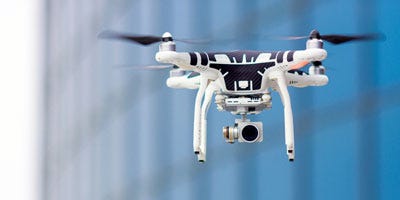 Drones, however, may be the ultimate tool for corporate espionage. For one thing, rival companies can use drones to carry out this same basic scenario from Silicon Valley. After all, it’s common for whiteboards to display financial information, notes on the company’s strategy, technological diagrams, and so forth. All a drone operator has to do is to find one of these whiteboards facing a window and snap some pictures—it doesn’t matter if it is on the first floor or the thirtieth.
Drones, however, may be the ultimate tool for corporate espionage. For one thing, rival companies can use drones to carry out this same basic scenario from Silicon Valley. After all, it’s common for whiteboards to display financial information, notes on the company’s strategy, technological diagrams, and so forth. All a drone operator has to do is to find one of these whiteboards facing a window and snap some pictures—it doesn’t matter if it is on the first floor or the thirtieth.
Note: The topic of IoT security is a key item on the agenda at Internet of Things World in Santa Clara this May. Check out the agenda for the world’s biggest IoT event.
Drone operators have also used this basic approach to spy on everything from prototype car models, the filming of Game of Thrones, and Apple’s new “spaceship” campus before it officially opens. There has also been an uptick in reports of drones flying over company facilities that are potential M&A targets, says JB McDowell, a sales engineer at Dedrone.
4. High-Tech Corporate Espionage
Having a drone hover outside of a board room and snap pictures may be daring, but it isn’t very sophisticated. Some of the most damaging drone-related hijacks involve computer hacking. There are, for instance, reports of drones loaded with a Raspberry Pi that can land atop a data center and steal sensitive information. “The drone will die but comes equipped with a separate power source for its components so that it will continue to sniff and transmit data over time,” says Kunal Jain, enterprise sales manager at Dedrone. “One of our partners has found a drone like that on top of a building. The drone was rusted and dead, but the components were still working.”
5. Smuggling
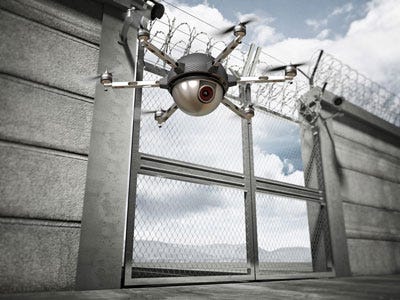 Many prisons across the United States are working to stop drones from smuggling everything from drugs, pornography, and smartphones to prisoners. Last year, a fight erupted at an Ohio prison after a drone dropped heroin into the exercise yard. Drug cartels have also used drones to ferry their wares across the Mexican–U.S. border.
Many prisons across the United States are working to stop drones from smuggling everything from drugs, pornography, and smartphones to prisoners. Last year, a fight erupted at an Ohio prison after a drone dropped heroin into the exercise yard. Drug cartels have also used drones to ferry their wares across the Mexican–U.S. border.
6. Collisions
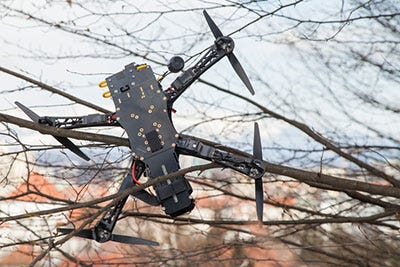 There have been a handful of reports of serious injuries from lightweight drones colliding into people. But collisions between 50-pound commercial drones could prove fatal, based on a recent article from Bloomberg that summarized the results of drone research involving crash-test dummies. “If you’re operating a large, multi-rotor aircraft in really close? proximity to people and treating it as if it’s a toy, then I think it’s asking for some pretty severe outcomes,” explained Mark Blanks, director of the government-approved drone test center at Virginia Tech.
There have been a handful of reports of serious injuries from lightweight drones colliding into people. But collisions between 50-pound commercial drones could prove fatal, based on a recent article from Bloomberg that summarized the results of drone research involving crash-test dummies. “If you’re operating a large, multi-rotor aircraft in really close? proximity to people and treating it as if it’s a toy, then I think it’s asking for some pretty severe outcomes,” explained Mark Blanks, director of the government-approved drone test center at Virginia Tech.
7. The Difficulty of Enforcing the Rules
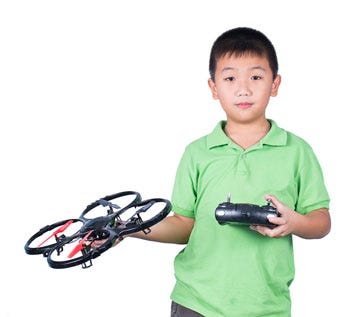 Authorities are attempting to crack down on drones flying in sensitive areas such as near airports or crowded sporting events. At the Super Bowl this year, for instance, FAA set up a 34.5-mile “no-drone zone” around the stadium. But the problem is that such no-fly zones are difficult to enforce. Radar has a hard time picking up drones, making it easy for some random guy in his backyard or in the back of a truck to fly a drone into a sensitive airspace undetected. “What happens if a kid goes out and flies a drone near an airport? Do you prosecute the child, the parents? What would you do?” asks Jain.
Authorities are attempting to crack down on drones flying in sensitive areas such as near airports or crowded sporting events. At the Super Bowl this year, for instance, FAA set up a 34.5-mile “no-drone zone” around the stadium. But the problem is that such no-fly zones are difficult to enforce. Radar has a hard time picking up drones, making it easy for some random guy in his backyard or in the back of a truck to fly a drone into a sensitive airspace undetected. “What happens if a kid goes out and flies a drone near an airport? Do you prosecute the child, the parents? What would you do?” asks Jain.
8. Drone-Based Hacking
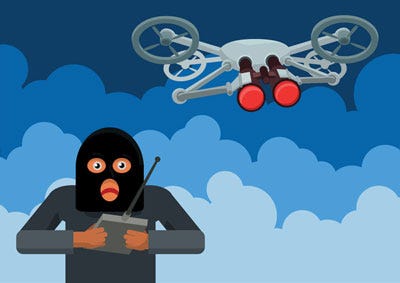 Drones also open up an array of new avenues for hackers. Not only can drones be hacked in flight, causing them to crash, the craft also can be used for stealing sensitive information from the public. It wouldn’t be hard for a drone to hover 150 feet above a park, broadcast a WiFi signal overhead, and then grab sensitive information from anyone using the network, for instance. In 2014, the security firm SensePost showed the feasibility of such attacks with its so-called Snoopy Drone.
Drones also open up an array of new avenues for hackers. Not only can drones be hacked in flight, causing them to crash, the craft also can be used for stealing sensitive information from the public. It wouldn’t be hard for a drone to hover 150 feet above a park, broadcast a WiFi signal overhead, and then grab sensitive information from anyone using the network, for instance. In 2014, the security firm SensePost showed the feasibility of such attacks with its so-called Snoopy Drone.
Image credits: Thinkstock
About the Author
You May Also Like






